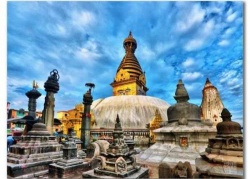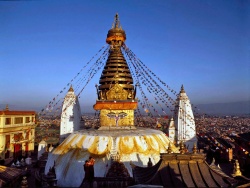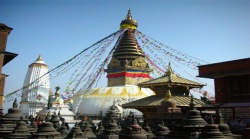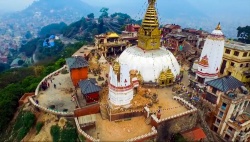Swayambhu
Situated about 3 km. from the centre of the city of Kathmandu, Nepal, at its north-western limits, this stupa or chorten's full name, Swayambhunath, means The Self-manifested Lord.
Swayambhu is on a steep hill above the valley of Kathmandu, and is believed to derive from a time when, tradition says, the whole area was under the waters of a vast lake in a territory that was once home to nagas.
Vipashwi (Tib. Namparzi) Buddha is credited with having sown the lotus seeds which grew into a giant jeweled lotus there.
Several buddhas and bodhisattvas are said to have visited in prehistoric times including Vajradhara and Manjushri.
Keith Dowman in A Buddhist Guide to the Power Places of the Kathmandu Valley tells us that Tibetans refer to the stupa as a grove (Skt. chaitya), the place of 'Phags-pa shing-kun' or Sublime Trees where:
" ... the Jina Vajradhara spontaneously arose from
the Pure Land of Akanistha as a great sacred Tree of Life
(mChod-sdong chen-po -- a Bodhi Tree or stupa) called Jnana Gandola Swayambhu (The Self-Sprung Temple of Wisdom) which brings spiritual release by sight of it, hearing of it, reflecting upon it, or touching it.
Look into Newar chronicles called the Swayambhu Purana for extensive details on the arising of thirteen billion times
more merit (for practising mantra etc.) in this place than in other great power places, and other interesting topics. "
Another tradition says that Manjushri used his sword to drain the lake that once filled the Kathmandu Valley, and then miraculous lotus flower came to rest on the spot. Manjushri was moved to become an ascetic, and like the Buddha and thousands of other yogis, he cut his hair. Where the strands fell, up sprang a grove of trees, and the omnipresent lice that infested the hair became the monkeys that live there. Though often referred to by visitors as 'the monkey temple,' many other temple grounds in the region are also home to troops of them.
Swayambhu was a very small thing when it first appeared, but it grew over time; suffered demolition from earthquakes and invaders, and was whitewashed and plastered over and restored several times throughout the years.
An inscription says that King Maladeva ordered work done on the site in 460 CE, and we know that by the 1200's it was a renowned Buddhist center. In 1346, Muslim invaders broke open the stupa looking for gold.
Via sponsors and donations the building complex has grown until the circumference of the entire site including the land now reaches about 5 km. Pictured above is only the dome of Swayambhu.
The 13 steps of the spire represent the levels of attainment required of a bodhisattva in order to achieve buddhahood.
See the levels or bhumis in Numbers in Buddhism.
The entire structure is a cosmic mandala and the three main parts -- spire, dome and base (which is not shown here) - represent the mantra of the three kayas.
The various geometric shapes that comprise the entire structure also represent the traditional elements such as earth, fire, air and water.
It is reached via a staircase of 365 steps.
Set around the base of the stupa is a continuous series of prayer wheels that are set into motion by the hands of pilgrims and tourists as the circumambulate the site.
The spinning wheels are believed to activate mantras and blessings.
The colorful prayer flags serve the same function when the wind sets them in motion.
The dome is sealed today, but there is a shrine room in which monks do regular practice.
Swayambhu was one of the first stops His Holiness Rigpe Dorje, the 16th Karmapa made after emerging from Tibet in 1970.
More history of this stupa.
A new translation of the Svayambhu Purana: A Discourse on the Origin of Svayambhu Stupa in Kathmandu Valley by the Nagarjuna Institute is currently the only complete translation.
It is based on the earliest manuscript dating from 1558 CE (678 Nepal Era.)
The 326-page text has ten chapters comprising 1750 verses and contains a summary in English of all the chapters with an historical introduction.
Both His Holiness Dalai Lama and Ven. Thrangu Rinpoche have given words of blessings in the foreword.



